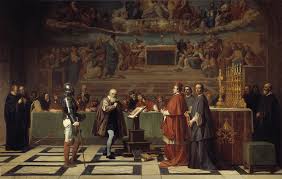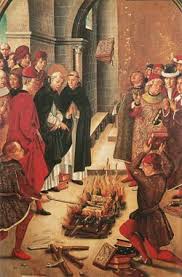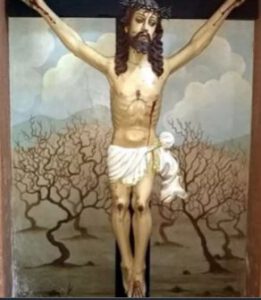Considering that the secular mind is quick to make the very word ‘Inquisition’ look odious, is it not its bounden duty to also check its own moral standards? Can our generation be sure that future generations will not be as uncharitable towards us as we have been vis-à-vis the Inquisition?
It is only fair that an institution or an event be looked at in the light of its age. Hence, before we draw up a balance sheet of the Inquisition, let’s look at some of its features. When the medieval institution was eventually replicated in many countries, there were inevitable changes in its set-up from place to place; however, its nature and procedures remained essentially the same, as outlined below.
Features of the tribunal
a) Nature: Ecclesiastical courts dealt regularly with disputes concerning discipline, administration of the church, and spiritual matters. But in places where heretics were strongly entrenched, the Church set up the inquisition as a special court with permanent judges or inquisitors. It was a formal court with rules of canonical procedure; its judges executed doctrinal functions in the name of the Pope. Thus, the Congregation of the Holy Roman and Universal Inquisition, or Holy Office, established in Rome in 1542 was historically continuous with the episcopal courts of earlier times and with the ones set up later. In the age of liberalism the powers of the tribunal came to be limited by local control and resistance.

At establishment of the inquisition in the thirteenth century, members of the Dominican and Franciscan Religious Orders, newly set up then, were offered the inquisitorial task, in view of their superior theological training. There is no reason to believe that those judges were in any way intellectually and morally inferior to their counterparts in modern judicial tribunals. Some inquisitors were no doubt harsh; but their lot has to be judged as a whole. Some errant inquisitors were even deposed and then incarcerated for life.
b) Procedure: Any new inquisition tribunal began by declaring a “period of grace” for the local Catholics. When summoned before the inquisitor, those who confessed their faults of their own accord were given a mild penance. When suspects did not report, and meanwhile much evidence had been obtained against them through the parish priest or lay persons, such suspects were cited before the judges and the trial began. If they made a clean breast of their faults, the affair was soon concluded to the advantage of the accused. If they entered denial even after swearing on the Gospels, the evidence already collected was put forward.
It is not known for sure whether the accused were imprisoned throughout the period of judicial inquiry. It seems quite unlikely that they would be, considering the burden on the exchequer. Nor was it even necessary, for freedom of movement was conditional: the suspect had to promise under oath to be available for inquiry and to accept the inquisitor’s sentence with good grace. Obviously, the judge would be favourably inclined if the suspect kept the oath. Besides, the inquisitor could grant bail or have reliable bondsmen to stand surety.
Medieval courts used torture as means of eliciting the truth. The inquisition adopted the method a few decades after its inception – and it is still part of judicial inquiry in many countries. However, torture was permitted only after all other expedients (counselling, coaxing, instilling fear of death, and even confinement) had been exhausted, or if the accused was inexact in his statements and virtually convicted by manifold and weighty proofs.
Torture was to be applied only at any one stage of the inquiry and without causing loss of life or limb. Many a judge skipped this procedure, considering it deceptive and ineffectual, but there were others who depended on it and even exceeded their authority. This made the inquisitor and other officials liable for suspension. Sometimes pressure was exerted in this regard by the civil authorities, overshadowing the ecclesiastical purposes of the inquisition.
While it was mandatory to have depositions by at least two witnesses, some judges would demand more. The Church initially believed that testimony of an “infamous” person was worthless before the courts, but later began to accept their evidence at nearly full value in trials concerning the Faith. Similarly, while at first it was a rule to withhold the names of the witnesses from the accused person, by and by naming witnesses was mandatory, but no personal confrontation of witnesses or any cross-examination ever allowed. Needless to say, false witnesses were severely punished.
It is a pity that witnesses hesitated to appear for the defence, fearing that they would be suspected of heresy. Similarly, the defendant rarely secured legal advisers, so those accused were obliged to respond personally to the main points of a charge. If thrown behind bars, they were given pen and paper for the purpose but no books to read or refer to. Years later, the law provided for heretics to be granted a legal adviser who was beyond suspicion – upright, skilled in civil and canon law, and zealous for the faith.
The accused could let the judge know his enemies; and should these turn out to be the accusers in the case, the charges would be quashed.

c) Bishop and the councils: These were introduced as a system of checks and balances, to save the inquisition tribunals from arbitrariness and caprice. The accused were also referred to the bishop who together with the inquisitor and a number of boni viri – upright and experienced men well versed in theology and canon law – would be summoned for the purpose of deciding on two questions: whether guilt lay at hand and what punishment was to be inflicted.
To preclude personal considerations, cases would be submitted to the council without naming any names. The role of the good men was advisory in nature, yet the final ruling was usually in accordance with their views.
The inquisitors were also assisted by a consilium permanens, or standing council, composed of other sworn judges.
d) Revision: When a decision was revised, it was in the direction of clemency.
e) Imprisonment: If the prison conditions were not up to the mark, the local bishop was supposed to look into the matter. If necessary, he would have meals provided to the prisoner from the proceeds of the confiscated property belonging to the latter.
f) Right to Appeal: The accused could reject a judge if he sensed some prejudice and, at any stage of the trial, appeal to a higher tribunal in the country’s capital or in Rome. The documents of the case would be dispatched there under seal. People would not do so as a matter of course, considering the time and money that it entailed; but sometimes it was considered worth the effort.
g) Punishment: One or two days prior to the formal pronouncement of the verdict,the charges were read out to the respective persons again and in the vernacular. Then they would be told where and when to appear to hear the verdict.
The final decision was usually pronounced with solemn ceremonial at the sermo generalis (a short discourse or exhortation), which later came to be known as auto-da-fé (act of faith). This was not a regular affair; it was held biennially or triennially, or even more rarely.

The auto-da-fé ceremony began very early in the morning. It comprised Mass, prayer, a public procession of those found guilty, and a reading of their sentences. It was followed by the investiture of the secular officials, who were made to vow obedience to the inquisitor in all things pertaining to the suppression of heresy. The so-called “decrees of mercy” (commutations, mitigations, and remission of previously imposed penalties) were followed by a fresh listing of offences and due punishments assigned to the guilty.
The listing went on from the minor to the major punishments, all of them as per the law in force. Some punishments were simply penitential in nature: building or visiting a church, going on pilgrimage more or less distant, offering a candle or a chalice, and the like. Minor punishments also included fines; road-making; whipping; the pillory, and so on. Major punishments comprised imprisonment in various degrees; confiscation of property; excommunication and the consequent surrender of the accused to the civil power for life imprisonment or death at the stake.
The auto-da-fé brought the inquisitional proceedings to an end.
h) Victims
For some, the word ‘Inquisition’ conjures up dreadful images of people arbitrarily sent to the stake. But the facts don’t bear out those fears. What those unscrupulous critics have done down the centuries is point out a few high-profile cases of clerics, scientists, and even saints (St Joan of Arc, Galileo Galilei, Edgardo Mortara, Giordano Bruno, among others) and then generalise about the inquisition. And about these heavy-weights, they hardly ever qualify their remarks.
Punishments in perspective
The indisputable fact is that, due to partial unavailability of records, many finer details are not known for sure. For instance, the number of those who died at the stake cannot be determined even with approximate accuracy. No serious historian, however, has ever stated that the figure is unconscionably high, for available data bears out the contrary. In fact, the numbers seem very low compared with the high-sounding rhetoric surrounding the tribunal.
Beginning from the nineteenth century, historians gradually compiled statistics drawn from the surviving court records. For instance, according to information available on Wikipedia, Inquisition historians Gustav Henningsen and Jaime Contreras studied the records of the Spanish Inquisition, which list 44,674 cases of which 826 resulted in executions in person and 778 in effigy (a straw dummy was burned in place of the person). Professor William Monter estimated there were 1000 executions between the years 1530–1630 and 250 between the years 1630–1730. Spain specialist Jean-Pierre Dedieu studied the records of the Toledo tribunal, which put 12,000 people on trial. For the period prior to 1530, British historian Henry Kamen estimated there were about 2,000 executions in all of Spain’s tribunals. Italian Renaissance history professor and Inquisition expert Carlo Ginzburg had his doubts about using statistics to reach a judgment about the period given that in many cases the evidence has been lost.

The same holds true for Goa, where the first tribunal outside Europe was established in the year 1560 and functioned intermittently up to 1812. According to history professor José Pedro Paiva of Coimbra, there are many reasons for the loss of the original archival sources pertaining to Goa. Meanwhile, he reckons that out of approximately 15,000 trials, there were more than 200 death sentences over a period of 250 years.
Further, The Catholic Encyclopaedia too provides valuable statistics about a few Inquisition tribunals in France. At Pamiers, from 1318 to 1324, five out of 24 persons convicted were delivered to the civil power; and at Toulouse from 1308 to 1323, only 42 out of 930 similarly bear the ominous note relictus culiae saeculari. At Pamiers one in 13 and at Toulouse one in 42 seem to have been burnt for heresy, even while these places were hotbeds of heresy and principal centres of the Inquisition, and the period the most active one for the institution.
Even when confronted with such unimpressive numbers, those biased critics make it a point to dub punishments of a bygone era ‘atrocious, ‘barbaric’, ‘cruel’, and so on. They conveniently forget that the same could be said of modern societies that blatantly, whimsically, and sometimes furtively engage in such acts, so unbecoming of purportedly enlightened democracies.
It would therefore be apt to conclude this section by quoting Robert Held, an anti-torture and anti-death-penalty proponent, who puts torture in perspective in his book titled Torture Instruments: “Neither the Roman nor the Spanish Inquisition used methods in any way different from those in everyday use by secular justice everywhere – in this sense it is an error to think of stake, rack and wheel as inventions of or even as attributes peculiar to either. Nothing went on in inquisitional dungeons or places of execution that would have seemed excessive, let alone unusual, to any plebe, prince or burgher of the times.”

The same could be said of the Goa Inquisition – but it is not our intention to elaborate on the subject at the moment. In the forthcoming and final instalment of this three-part series we shall proceed to draw up a general assessment of the redoubtable tribunal in question.
(To be concluded…3)
Normalmente os laicos, ateus, deístas, iluministas, etc., e no caso de Goa os que amaldiçoam a igreja católica e certos políticos, agarram-se a Inquisição para defender que a mesma foi um instrumento de castigo do pior que existiu no mundo. Mesmo os que tem conhecimento geral da história do mundo e das diversas mentalidades e ideias, teimam-se numa análise e discussão isolada do tema, mas muitas das vezes muitos outros desses intervenientes tem apenas bases superficiais das coisas e da política, apenas para defender o seu modo de vida e pensamento. É verdade a inquisição foi um sistema que, embora inicialmente criado para apenas purificar a fé cristã católica, usou métodos medievais e terríveis e houve casos também de usurpação dos bens dos acusados. Os próprios auto-de-fé eram um ritual em que o povo assistia como se fosse uma coisa mais natural possível, tal como o sistema de “pira” hindú, das mortes das viúvas nessa fogueira do marido falecido. O povo acredita sempre, ainda hoje, naquilo que os políticos e chefes partidários, defendem. O mesmo sucede nas prisões, tribunais, e dos vencidos nas guerras atuais. Mas neste caso da inquisição coitado dos que morriam como “relapsos” e tinham ainda a hipótese duma morte mais suave se não renegassem o cristianismo, mas apesar disso mantivessem as suas convicções erradas, utilizando o método de sangria, o que os punham inconscientes, os outros enfrentavam vivos o fogo e o seu padrinho o abandonava por isso e eram entregue ao poder civil para executar a pena de morte na fogueira atado num poste. A classe dos convictos perdiam os bens e eram excomungados. Os que confessavam tudo ficavam livres, mas podiam também sofrer conforme a culpa a penitência, rezar, ou até castigo nas galés.